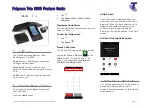
3. TECHNICAL BRIEF
- 7 -
Copyright © 011 LG Electronics. Inc. All right reserved.
Only for training and service purposes
LGE Internal Use Only
Since GSM-850, GSM-900, GSM-1800, and GSM-1900 signals are time-division duplex (the handset can only
receive or transmit at one time), switches are used to separate Rx and Tx signals in place of frequency duplexers
– this is accomplished in the switch module. The GSM-850, GSM-900, GSM-1800, and GSM-1900 receive signals
are routed to the QTR8200/8600 through band selection filters and matching networks that transform single-
ended 50-ohm sources to differential impedances optimized for gain and noise figure. The QTR input uses a
differential configuration to improve second-order intermodulation and common mode rejection performance.
The QTR8200/8600 input stages include MSM-controlled gain adjustments that maximize receiver dynamic
range.
The amplifier outputs drive the RF ports of the quadrature RF-to-baseband downconverters.
The downconverted baseband outputs are multiplexed and routed to lowpass filters (one I and one Q) having
pass band and stop band characteristics suitable for GMSK or 8-PSK processing. These filter circuits include DC
offset corrections. The filter outputs are buffered and passed on to the MSM8255 IC for further processing as
shown in Figure 3.2.3.
G
G
[Figure 3.2.3] GSM receivers and example application
















































